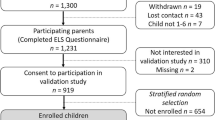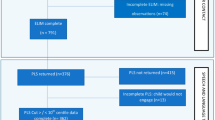Abstract
Purpose of Review
A brief literature review of the past 5 years was conducted to provide updated information regarding language screening at all ages. Included will be information regarding classification accuracy of commercially available tools, as well as current methods reported in recent literature for early intervention, preschool, school age, adolescent, and adult populations.
Recent Findings
Based on a brief literature review of the past 5 years, there seem to be very little novel or important new findings in this area.
Summary
To date, there is no gold standard for language screening at any age. While there are some standardized screening tools, these screeners must be used with caution as they may produce false negative results, thereby negating their efficacy. Currently, adolescents stand out as an at-risk group due to the lack of age-appropriate, standardized screening measures addressing this population.
Similar content being viewed by others
References
Papers of particular interest, published recently, have been highlighted as: • Of importance •• Of major importance
•• Hendricks AE, Adlof SM, Alonzo CN, Fox AB, Hogan TP. Identifying children at risk for developmental language disorder using a brief, whole-classroom screen. J Speech Lang Hear Res. 2019;62:896–908. https://doi.org/10.1044/2018_JSLHR-L-18-0093 This study considers the potential of whole classroom language screening.
Davis GN, Lindo EJ, Compton DL. Children at risk for reading failure: constructing an early screening measure. Teach Except Child. 2007;39(5):32–7.
• Larson A. Language screening for infants and toddlers: a literature review of four commercially available tools. Commun Disord Q. 2016;38(1):3–12 A literature review of four tools for use with infants and toddlers.
U.S. Census Bureau. Quick facts. 2017. Available from: https://www.census.gov/quickfacts/fact/table/US/PST045219.
Fernald A, Marchman V, Weisleder A. SES differences in language processing skills and vocabulary are evident at 18 months. Dev Sci. 2013;16(2):234–48.
Morgan PL, Farkas G, Hillemeir MM, Mattison R, Maczuga S, Li H, et al. Minorities are disproportionately underrepresented in special education: longitudinal evidence across five disability conditions. Educ Res. 2015;44(5):278–92.
Individuals with Disabilities Education Act. Section 303.303 Referral Procedures. 2015. Retrieved from: https://sites.ed.gov/idea/regs/c/d/303.303.
Accardo PJ, Capute AJ. The Capute Scale: Cognitive Adaptive Test/Clinical Linguistic & Auditory Milestone scale (CAT/CLAMS). Baltimore, MD: Paul H. Brookes; 2005.
Coplan J. Early Language Milestone Scale-second edition (ELM Scale-2). Austin, TX: PRO-ED; 2003.
Rescorla L. The language development survey: a screening tool for delayed language in toddlers. J Speech Hear Disord. 1989;54:587–99.
Fenson L, Petick S, Renda C, Cox JL, Dale PS, Resnick JS. Short-form versions of the MacArthur Communicative Development Inventories. Appl Psycholinguist. 2000;2:95–116.
• Moodie S, Daneri P, Goldhagen S, Halle T, Green K, LaMonte L. Early childhood developmental screening: A compendium of measures for children ages birth to five (OPRE Report 201411). 2014. Washington, DC: Office of Planning, Research and Evaluation, Administration for Children and Families, U.S. Department of Health and Human Services. This compendium highlights areas where the early childhood assessment field is lacking information regarding reliability of available screening tools.
•• Virginia Department of Education, Office of Special Education and Student Services. Speech-language pathology services in schools: guidelines for best practice. 2018. Available from: http://www.doe.virginia.gov/special_ed/disabilities/speech_language_impairment/slp-guidelines-2018.pdf. This document provides guidelines for best practices for SLPs in the public school setting.
• Wallace IF, Berkman ND, Watson LR, Coyne-Beasley T, Wood CT, Cullen K, et al. Screening for speech and language delay in children 5 years old and younger: a systematic review. Peds. 2015;136:3448 This is a systematic review of screening instruments that accurately identify language impairment/delays/disorders.
Squires J, Bricker D, Twombly E. Ages & Stages Questionnaires®: Social-Emotional, Second Edition (ASQ®:SE-2): a parent-completed child monitoring system for social-emotional behaviors. Baltimore: Paul H. Brookes Publishing Co., Inc.; 2015.
Wetherby A, Prizant B. The infant toddler checklist from the communication and symbolic behavior scales. Baltimore: Brookes Publishing; 2002.
Fenson L, Marchman VA, Thal DJ, Dale PS, Reznick JS, Bates E. MacArthur-Bates Communicative Development Inventories: user's guide and technical manual. 2nd ed. Baltimore, MD: Brookes; 2007.
Fluharty NB. Fluharty preschool speech and language screening test. Allen, TX: DLM Teaching Resources; 1978.
Bliss LS, Allen DV. Screening kit of language development: a preschool language screening instrument. J Commun Disord. 1986;17(2):133–41. https://doi.org/10.1016/0021-9924(84)90019-4.
•• Eisenberg S, Victorino K, Murray S. Concurrent validity of the Fluharty Preschool Speech and Language Screening Test-Second Edition at Age 3: comparison with four diagnostic measures. Lang Speech Hear Serv Sch. 2019;50:673–82 This study examines the concurrent validity of the Fluharty Preschool Speech and Language Screening Test for 3-year-old children.
Dawson J, Eyer JA, Fonkalsrud J. Structured photographic expressive language test—preschool: second edition. DeKalb, IL: Janelle Publications; 2005.
Adlof S, Scoggins J, Brazendale A, Babb S, Petscher Y. Identifying children at risk for language impairment or dyslexia with group-administered measures. J Speech Lang Hear Res. 2017;60:3507–22.
Williams KT. Group reading assessment and diagnostic evaluation. Circle Pines, MN: American Guidance Service; 2001.
Mather N, Hammill D, Allen EA, Roberts R. Test of silent word reading fluency. Austin, TX: Pro-Ed; 2004.
Bishop DVM. Test for reception of grammar - version 2 (TROG-2). London: Pearson; 2003.
American Speech Hearing Association. Available from: https://www.asha.org/PRPSpecificTopic.aspx?folderid=8589935327§ion=Assessment
Prather E, Van Ausal BS, Wallace EM. Screening test of adolescent language (STAL). Terrance CA: Western Psychological Services; 1980.
Prather E, Brenner A, Hughes K. A mini speech language test for adolescents. Lang Speech Hear Sch. 1981;12:67–73.
Wiig EH, Semel E, Secord WA. Clinical evaluation of language fundamentals- fifth edition: screening test (CELF-5 screening test). New York: Pearson; 2013.
American Speech Language Association. Practice portal: aphasia screening. Available from: https://www.asha.org/PRPSpecificTopic.aspx?folderid=8589934663§ion=Assessment#Screening
Hachioui HE, Visch-Brink EG, de Lau LML, van de Sandt-Koenderman MW, Nouwens F, Koudstaal PJ, et al. Screening test for aphasia in patients with stroke: a systematic review. J Neurol. 2007;264:211–20.
Enderby PM, Wood VA, Wade DT, Hewer RL. The Frenchay aphasia screening test: a short, simple test for aphasia appropriate for non-specialists. Int Rehabil Med. 1987;8:166–70.
Flamand-Roze C, Falissard B, Roze E, Maintigneur L, Beziz J, Chacon A, et al. Validation of a new language screening tool for patients with acute stroke: the Language Screening Test (LAST). Stroke. 2011;42:1224–0.
Nakase-Thompson R, Manning E, Sherer M, Yablon SA, Gontkovsky SL, Vickery C. Brief assessment of severe language impairments: initial validation of the Mississippi aphasia screening test. Brain Inj. 2005;19(9):685–91.
Doesborgh SJ, van de Sandt-Koenderman WM, Dipple DW, van Harskamp F, Koudstaal PJ, Visch-Brink EG. Linguistic deficits in the acute phase of stroke. J Neurol. 2003;250:977–82.
Syder D. Sheffield screening test for acquired aphasia. Windson: NFER Nelson; 1993.
Lopes M, Dozzi Brucki SM, Giampaoli V, Mansur LL. Semantic verbal fluency test in dementia: preliminary retrospective analysis. Dement Neuropsychol. 2009;3(4):315–20.
Thommessen B, Thoresen GE, Bautz-Holter E, Laake K. Screening by nurses for aphasia in stroke –the Ullevaal Aphasia Screening (UAS) test. Disabil Rehabil. 1999;21:110–5.
Crary MA, Haak NJ, Malinsky AE. Preliminary psychometric evaluation on an acute aphasia screening protocol. Aphasiology. 1989;3:611–8.
Biniek R, Huger W, Glindemann R, Willmes K, Klumm H. The Aachen aphasia bedside test-criteria for validity of psychologic tests. Nervenarztn. 1992;63:473–9.
Kertesz A. Western aphasia battery revised. San Antonio: Harcourt Assessment; 2006.
DeRenzi E, Vignolog LA. The token test: a sensitive test to detect receptive disturbances in aphasics. Brain. 1962;85:665–78.
American Speech and Hearing Association. Scope of practice in speech language pathology. 2020. Available from https://www.asha.org/policy/sp2016-00343/
Demeyere N, Riddoch MJ, Slavkova ED, Bickerton WL, Humphreys GW. The Oxford Cognitive Screen (OCS): validation of a stroke-specific short cognitive screening tool. Psychol Assess. 2015;27:883–94.
Berit A, Dehlin O. The clock drawing test. Age Aging. 1998;27:399–403.
Teng EL, Chui HC. The Modified Mini-Mental State (3MS) examination. J Clin Psychiatry. 1987;8:314–8.
Nasreddine ZS, Phillips NA, Bedirian V, et al. The Montreal Cognitive Assessment, MoCA: a brief screening tool for mild cognitive impairment. J Am Geriatr Soc. 2005;53(4):695–9.
Barnay JL, Wauquiez G, Rousseaux M, Bonnin-Koag HY, Dischler F, De Boissezon X, et al. Presentation of the cognitive assessment scale for stroke patient (CASP). Ann Phys Rehabil Med. 2012;55.
Niven E, Newton J, Foley J, Colville S, Swingler R, Chandran S, et al. Validation of the Edinburgh Cognitive and Behavioural Amyotrophic Lateral Sclerosis Screen (ECAS): a cognitive tool for motor disorders. Amyotroph Lateral Scler Frontotemporal Degener. 2015;16:172–9.
•• Macoir J, Fossard M, Lefbvre L, Monetta L, Renard A, Tran T, et al. Detection test for language impairments in adults and the aged-a new screening test for language impairment associated with neurodegenerative diseases: validation and normative data. Am J Alzheimer’s Dis Other Dementias. 2017;32(7):382–92 This study provides validation and standardization of a new language screening test for neurodegenerative disease.
Enderby PM, Wood VA, Wade DT, Hewer RL. The Frenchay aphasia screening test: a short, simple test for aphasia appropriate for non-specialists. Int Rehabil Med. 2009;8(4):166–70.
Nakase-Thompson R, Mannin GE, Shere M, Yablon SA, Gontkovsky SL, Vickery C. Brief assessment of severe language impairments: initial validation of the Mississippi aphasia screening test. Brain Inj. 2005;19(9):685–91.
Tsoi KK, Chang JYC, Hirai HW, Wond SYS, Kwok TCY. Cognitive tests to detect dementia: a systematic review and meta-analysis. JAMA Intern Med. 2015;175(9):1450–8.
Borson S, Scanlan J, Brush M, Vitaliano P, Dokmak A. The Mini-Cog: a cognitive “vital signs” measure for dementia screening in multi-lingual elderly. Int J Geriatr Psychiatry. 2000;15(11):1021–7.
Mioshi E, Dawson K, Mitchell J, Arnold R, Hodges JR. The Addenbrooke’s Cognitive Examination Revised (ACE-R): a brief cognitive test battery for dementia screening. Int J Geriatr Psychiatry. 2006;21(11):1078–85.
Blanton DJ, Dagenais PA. Comparison of language skills of adjudicated and adjudicated adolescent males and females. Lang Speech Hear Serv Sch. 2007;34(4):309–14.
Statten H, Klackenberg-Larsson I. Early language and intelligence development and their relationship to future criminal behavior. J Abnorm Psychol. 1993;103(3):369–78.
Author information
Authors and Affiliations
Corresponding author
Ethics declarations
Conflict of Interest
The authors declare that they have no conflict of interest.
Human and Animal Rights and Informed Consent
This article does not contain any studies with human or animal subjects performed by any of the authors.
Additional information
Publisher’s Note
Springer Nature remains neutral with regard to jurisdictional claims in published maps and institutional affiliations.
This article is part of the Topical Collection on Communication Disorders
Rights and permissions
About this article
Cite this article
Longerbeam, M.S., Freeman, L.M. Language Screening: How Far Have We Come?. Curr Dev Disord Rep 7, 116–123 (2020). https://doi.org/10.1007/s40474-020-00198-7
Published:
Issue Date:
DOI: https://doi.org/10.1007/s40474-020-00198-7




